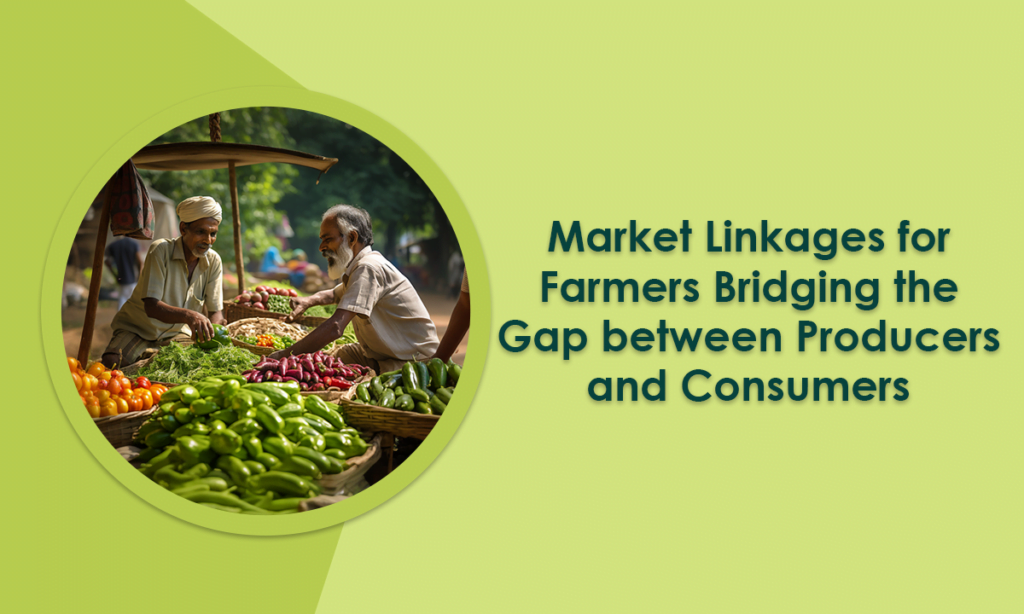Introduction
Agriculture serves as the cornerstone of India’s economy, providing sustenance to millions of livelihoods and making a substantial contribution to the nation’s overall growth. However, the traditional agricultural system grapples with challenges in effectively connecting farmers with markets, resulting in inefficiencies and income disparities. To bridge this gap between producers and consumers and ensure food security, market linkages play a pivotal role.
In this blog post, we will delve into the significance of market linkages from the Indian perspective, exploring how these connections can bring about transformative changes in the agricultural sector and uplift the lives of millions of farmers across the country.
Challenges in the Agricultural Supply Chain
India’s agricultural supply chain faces numerous hurdles that hinder efficient market linkages:
Middlemen and Exploitation: Farmers often depend on intermediaries to reach consumers, leading to unfair pricing and exploitation.
Lack of Information: Many farmers lack access to market information, resulting in poor decision-making and vulnerability to price fluctuations.
Infrastructure Deficits: Inadequate transportation, storage, and market facilities hinder the smooth flow of agricultural produce from farms to consumers.
Post-harvest Losses: Insufficient storage facilities lead to post-harvest losses, impacting farmers’ incomes and food security.
Limited Market Access: Small and marginal farmers struggle to access distant markets, restricting their reach and potential earnings.
Significance of Market Linkages
Market linkages address these challenges by creating direct connections between farmers and consumers, offering numerous benefits:
Fair Pricing: Direct market access empowers farmers to negotiate better prices for their produce, eliminating exploitation by middlemen.
Income Enhancement: Increased market opportunities lead to higher incomes, improving the economic well-being of farmers.
Reduced Wastage: Efficient market linkages minimize post-harvest losses by streamlining the transportation and storage of agricultural produce.
Market Information: Farmers gain access to real-time market information, enabling them to make informed decisions and plan their crops accordingly.
Diversification and Value Addition: Market linkages encourage diversification into high-value crops and value-added products, increasing farmers’ competitiveness.
Initiatives Promoting Market Linkages in India
To strengthen market linkages and enhance farmers’ access to markets, several initiatives have been introduced in India:
E-NAM (Electronic National Agriculture Market): Launched by the Government of India, E-NAM is an online platform that integrates agricultural mandis (markets), enabling farmers to sell their produce online and access a wider consumer base.
Farmer Producer Organizations (FPOs): FPOs are collective entities formed by farmers to pool their resources, negotiate better prices, and access markets directly.
Krishi Vigyan Kendras (KVKs): KVKs provide farmers with market-oriented training and linkages, enabling them to adopt sustainable and market-driven farming practices.
Private Sector Collaborations: Several private companies and startups have developed agritech platforms that connect farmers with buyers and provide market information.
The Way Forward
To fully leverage the potential of market linkages for farmers in India, there is a need for continued efforts from various stakeholders:
Strengthening Infrastructure: Investment in rural infrastructure, including roads, cold storage, and agro-processing units, is crucial to enable seamless movement of agricultural produce.
Digital Literacy: Promoting digital literacy among farmers will empower them to leverage online platforms and access market information.
Policy Support: The government must create an enabling policy environment that supports farmers’ access to markets and ensures fair trade practices.
Capacity Building: Capacity-building programs should be conducted to equip farmers with market-oriented skills and knowledge.
Conclusion
Market linkages are the key to unlocking the full potential of Indian agriculture and empowering farmers. By facilitating direct connections between producers and consumers, market linkages create a fair and efficient agricultural supply chain, benefiting farmers and consumers alike. Initiatives like E-NAM, FPOs, and private sector collaborations have already made significant strides in this direction, revolutionizing the way farmers access markets in India.
With continued support from the government, private sector, and civil society, market linkages will play a transformative role in boosting agricultural incomes, reducing wastage, and securing food security for the nation. As India marches towards agricultural prosperity, market linkages remain a vital tool in bridging the divide between farmers and consumers and transforming the rural landscape.

Pingback: The Future of Farming: Predictive Analytics, Drones, and AI in Agriculture - Sankalp Bhoomi Trust